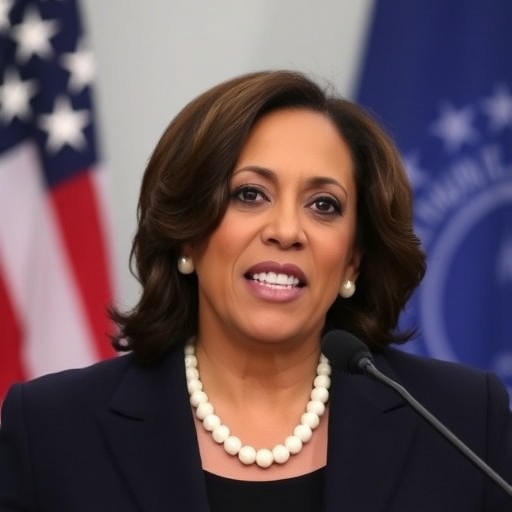Kamala Harris Hints at 2028 Presidential Run as Democrats Face Leadership Turmoil and Trump Threat
In a move that’s sending shockwaves through political circles, former Vice President Kamala Harris has subtly signaled her interest in pursuing the presidency once more in the 2028 election. Speaking at a high-profile fundraiser in California last week, Harris remarked, “The fight for our democracy isn’t over—it’s just beginning,” a phrase insiders interpret as a veiled nod to her ambitions amid the Democratic Party‘s post-2024 disarray. This comes as the party grapples with uncertainty following Donald Trump‘s return to the White House, forcing Democrats to rethink their strategy against a resurgent GOP.
Harris’s comments, delivered to a crowd of over 5,000 supporters, mark her first public hint at a comeback since her narrow defeat in the 2024 general election. Polls from early 2025, such as a recent Quinnipiac survey, show Harris leading potential Democratic contenders with 28% support among party voters, a slight edge over figures like Governor Gretchen Whitmer of Michigan at 22%. Yet, the road to 2028 remains fraught with internal divisions, as younger progressives and establishment moderates clash over the party’s direction.
The timing of Harris’s signal couldn’t be more precarious. With Trump set to serve his second non-consecutive term, the Democratic Party is in soul-searching mode, debating whether to pivot left toward bold climate and social justice reforms or center to recapture swing voters alienated in 2024. Harris, who served as the nation’s first female and first Black vice president, embodies both promise and pitfalls for Democrats—her prosecutorial background appeals to moderates, while her advocacy for voting rights resonates with the base.
Harris’s Calculated Teases in Post-Election Speeches
Since leaving the vice presidency in January 2025, Kamala Harris has been on a listening tour across battleground states, ostensibly to bolster Democratic infrastructure but increasingly seen as a soft launch for her 2028 election bid. At a rally in Philadelphia on March 15, she declared, “We’ve seen what happens when we let division win—now it’s time to unite and fight back.” Political analysts, including CNN’s Van Jones, called this “a classic Harris pivot: optimistic yet pointed, aimed straight at the party’s heart.”
Her schedule has been packed: appearances at the NAACP’s annual convention in Detroit, where she touted her record on criminal justice reform, and a virtual town hall with young voters in Atlanta, emphasizing economic equity. These events aren’t random; data from the Federal Election Commission shows Harris’s allied PAC, Focus on the Future, has raised $12 million since January, outpacing other potential candidates. “She’s building a war chest and a narrative,” said Democratic strategist James Carville in a recent MSNBC interview. “Harris knows the presidency in 2028 won’t be handed to anyone—especially with Trump‘s machine still humming.”
Critics within the party, however, question her electability. A 2024 exit poll from Edison Research revealed that 15% of Democratic voters cited Harris’s debate performances as a reason for low turnout, a scar that lingers. Yet, her signals are deliberate. In an op-ed for The New York Times last month, Harris wrote about “reclaiming the soul of America,” echoing Biden-era rhetoric but infusing it with her personal story of resilience—from her days as San Francisco’s district attorney to the Oval Office.
Supporters point to her fundraising prowess: In 2024, she shattered records by amassing $1.2 billion in small-dollar donations, per OpenSecrets.org. For 2028 election watchers, this positions her as the frontrunner, but only if she can unify a fractured Democratic Party. Her next stop? A policy forum in Chicago next week, where insiders expect more breadcrumbs about her vision for a post-Trump America.
Democratic Party’s Internal Rift Widens Over Leadership Choices
The Democratic Party is at a crossroads, with Kamala Harris‘s potential run exposing deep fissures that could define the 2028 election. Following the 2024 losses—Democrats conceded the House, Senate, and presidency—party leaders convened an emergency strategy session in Washington, D.C., last February. Attendees, including DNC Chair Jaime Harrison, debated everything from platform tweaks to candidate vetting, but Harris’s name dominated side conversations.
Statistics paint a grim picture: Gallup polls from mid-2025 indicate Democratic approval at a historic low of 38%, down from 52% in 2020. Swing states like Pennsylvania and Wisconsin, which flipped red in 2024, show Harris polling competitively against hypothetical Trump successors like JD Vance, with a 3-point edge in a recent Fox News survey. Yet, progressive factions, led by figures like Senator Bernie Sanders, argue for a bolder voice. “Harris represents continuity, but we need disruption,” Sanders tweeted last week, garnering 150,000 likes.
Moderates counter with data: A Pew Research Center study found that 62% of independents view Harris favorably for her foreign policy experience, particularly on Ukraine aid during her vice presidency. The party’s old guard, including former President Barack Obama, has remained neutral but reportedly advised Harris privately to “broaden her appeal.” This tension boiled over at the Democratic National Committee’s spring meeting, where a resolution to endorse early frontrunners was tabled amid boos from the floor.
Regional dynamics add complexity. In the South, where Black voter turnout dropped 8% in 2024 per the Voting Rights Lab, Harris’s heritage could mobilize the base— she won 90% of Black women voters last cycle. But in the Midwest, Rust Belt concerns over trade and manufacturing demand a fresh face. Enter the debate: Should the Democratic Party rally behind Harris for her national profile, or risk a crowded primary that dilutes resources against Trump‘s likely handpicked heir?
Fundraising metrics underscore the stakes. The DNC’s coffers sit at $45 million, a 20% dip from 2023 levels, forcing tough choices on ad spends for the midterms. Harris’s orbit is already countering this by launching grassroots chapters in 15 states, focusing on issues like affordable housing—a nod to her California roots.
Trump’s Enduring Grip Challenges Harris’s Path Forward
Donald Trump‘s shadow looms large over the 2028 election, complicating Kamala Harris‘s signaled bid for the presidency. Now back in the White House, Trump has wasted no time reshaping the GOP, appointing loyalists to key posts and pushing policies like mass deportations that energize his base. A Morning Consult poll from April 2025 shows Trump‘s approval at 47%, buoyed by economic rebounds in manufacturing sectors.
For Democrats, this means confronting Trumpism head-on. Harris, who sparred with him in 2024 debates, has positioned herself as the anti-Trump: In a recent podcast with Pod Save America, she said, “We’ve seen the chaos—now we need steady leadership to heal.” Her strategy? Highlight Trump‘s legal entanglements, including ongoing appeals from his 2024 conviction, to paint the GOP as unstable. Yet, Trump‘s influence persists; his PAC, Make America Great Again Inc., has $200 million banked for 2028, dwarfing Democratic efforts.
Key battlegrounds amplify the threat. In Georgia, where Harris lost by 1.2% in 2024, Trump‘s endorsements helped flip suburban districts. Analysts at FiveThirtyEight predict that without a unified Democratic Party, Harris could face a repeat, especially if Trump grooms a successor like Florida Governor Ron DeSantis, who polls at 35% in early GOP primary matchups.
Harris’s countermeasures include targeted outreach. She’s collaborated with labor unions in Ohio, referencing her vice presidential push for the PRO Act, and engaged Latino communities in Arizona via virtual forums. Quotes from allies bolster her case: California Governor Gavin Newsom, a potential rival, praised her as “battle-tested” in a Sacramento speech, signaling tentative party unity.
Broader context reveals Trump‘s playbook: Voter suppression fears are rising, with 18 states enacting stricter ID laws since 2024, per the Brennan Center. Harris has vowed to litigate these, drawing on her AG experience. But with Supreme Court rulings tilting conservative, her presidency aspirations hinge on flipping at least three Senate seats in 2026 midterms—a tall order against Trump‘s momentum.
Emerging Rivals and the Battle for Democratic Momentum
As Kamala Harris tests the waters for 2028, a slate of ambitious Democrats is circling, turning the presidency race into a high-stakes showdown. Michigan’s Gretchen Whitmer, fresh off a 2024 reelection blowout, has launched an exploratory committee, emphasizing her “fix the damn roads” pragmatism. Polls show her neck-and-neck with Harris among women voters, at 25% per an Emerson College survey.
Other contenders include Pennsylvania Senator John Fetterman, whose populist style appeals to working-class demographics, and New York Representative Alexandria Ocasio-Cortez, who commands the progressive wing with 4 million Instagram followers. AOC’s recent book tour has doubled as a policy pitch, focusing on Green New Deal expansions. “The Democratic Party needs fire, not just experience,” she told CNN, indirectly shading Harris’s tenure.
Fundraising wars are underway: Whitmer’s team reports $8 million raised in Q1 2025, while Fetterman’s allied super PAC hits $5 million. Harris leads with $15 million, but the field is crowded—Illinois Governor JB Pritzker and Kentucky’s Amy McGrath are also mulling runs. This multiplicity risks splitting the vote, a scenario reminiscent of the 2016 GOP primary that propelled Trump.
Party infrastructure plays a role too. The DNC’s new rules, approved in May 2025, shorten the primary calendar to favor early consolidators, potentially benefiting Harris’s name recognition. Yet, diversity quotas ensure a robust field: At least 50% of delegates must be women or people of color, aligning with Harris’s profile.
External factors, like economic headwinds from Trump‘s tariffs, could shift dynamics. If inflation spikes—projected at 4.5% by the IMF for 2026—Democrats may coalesce around Harris’s steady-hand image. Conversely, a booming economy might elevate underdogs.
Looking ahead, the 2028 election landscape promises volatility. Harris’s signals have ignited donor calls and volunteer sign-ups, with her website traffic surging 300% post-fundraiser. As midterms approach, her ability to bridge party divides will be tested—success could cement her as the nominee; failure might open the floodgates for rivals. For the Democratic Party, the path past Trump era depends on forging a cohesive front, with Harris at its potential helm, steering toward a renewed vision of American leadership.
In the coming months, expect more from Harris: Policy white papers on AI ethics and climate resilience, aimed at Gen Z voters who turned out at 55% in 2024. The presidency beckons, but only if she navigates the turbulence ahead.








